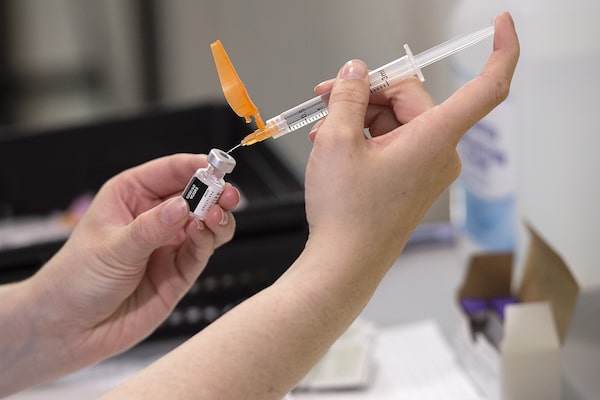With Canada’s colder weather comes respiratory virus season, and flus and RSV are circulating alongside the COVID-19 virus that remains with us. While Canadians learned a lot about how to protect themselves from illness over the course of the pandemic, new information released by health care practitioners can help inform decisions, from availability of flu shots to any changes in COVID protocols.
We’ll be publishing an update on respiratory virus season each week. Looking for more information on the topic that you don’t see here? E-mail audience@globeandmail.com to see if we can help you.

The Pfizer-BioNTech COVID-19 vaccine is prepared at a vaccination clinic in Dartmouth, N.S., on June 3, 2021.Andrew Vaughan/The Canadian Press
The latest news
- The fall COVID-19 shot cut the risk of COVID illness in half overall, and by 67 per cent for people with a previous confirmed infection, according to the Canadian network that also tracks the performance of the flu vaccine. The influenza vaccine was 63 per cent effective against A(H1N1), the dominant strain this season, the group concluded in its mid-season estimates.
- As of the week ended Feb. 17, the influenza indicators that the Public Health Agency of Canada tracks – test positivity rates, confirmed outbreaks, severe outcomes and overall flu activity – are holding steady at levels that are at or below expected levels for this time of year. The number of influenza B cases is rising, as often happens as spring approaches, but remains low.
- Respiratory Syncytial Virus levels are also stable and below expected levels for this time of year, according to PHAC’s latest surveillance report. RSV was a major ingredient in the viral stew that overwhelmed Canadian pediatric hospitals last season, when respiratory illnesses rebounded after COVID restrictions were lifted. A new report from the Canadian Institute for Health Information confirms just how hard last season was on children’s health facilities.
Flu shots
It’s not too late to get your flu shot. Influenza B, which is sometimes more dangerous to children than influenza A, is on the rise now. The strain often peaks in the spring. Flu shot appointments are still available for anyone six months and older.
Find out about clinics and availability for each of the provinces and territories here:
Newfoundland and Labrador; Prince Edward Island; Nova Scotia; New Brunswick; Quebec; Ontario; Manitoba; Saskatchewan; Alberta; British Columbia; Yukon; Northwest Territories; Nunavut
COVID boosters
The three authorized vaccines, manufactured by Pfizer-BioNTech, Moderna and Novavax, protect against the XBB.1.5 subvariant of COVID-19 and should provide good protection against the related JN.1 family, now dominant in Canada. The reformulated mRNA shots from Pfizer-BioNTech and Moderna are approved for anyone six months and older. Novavax’s shot is approved for those 12 and up.
COVID-19 vaccine information for the provinces and territories can be found here:
Newfoundland and Labrador; Prince Edward Island; Nova Scotia; New Brunswick; Quebec; Ontario; Manitoba; Saskatchewan; Alberta; British Columbia; Yukon; Northwest Territories; Nunavut
Flu outlook in Canada
Influenza indicators are stable, and continue to be at or below expected levels for this time of year. The influenza A season peaked at the end of December. There have been 3,652 hospital admissions linked to influenza in the fall and winter of 2023-24, with seniors accounting for nearly half of those admissions.
There have been 623 influenza-association admissions this season among children at eight Canadian hospitals that act as sentinel sites for tracking the severity of influenza in kids.
Hospitalization for COVID-19
Hospital admissions for COVID-19 continue to decline, according to PHAC. The total number of hospital beds occupied by COVID-19 patients fell to 2,531 beds in the week ended Feb. 20, down from 2,637 the week before.
Current health guidance for COVID-19
Symptoms of COVID-19 can vary, but generally include sore throat, runny nose, sneezing, new or worsening cough, shortness of breath or difficulty breathing, feeling feverish, chills, fatigue or weakness, muscle or body aches, new loss of smell or taste, headache, abdominal pain and diarrhea. According to Health Canada, you may start experiencing symptoms anywhere from one to 14 days after exposure. Typically, symptoms appear between three to seven days after exposure.
Health Canada advises following the testing guidelines provided by your local public health authority if you have symptoms or have been exposed to a person with COVID-19. If you test positive, immediately isolate yourself from others, including those in your household, and follow the advice of your local public health authority on isolation requirements.
How to protect yourself and your loved ones from respiratory viruses
Respiratory viruses are spread from person to person or through contact with contaminated surfaces, so it’s important to protect against both forms of transmission. Health Canada recommends wearing a medical mask or respirator, washing your hands regularly or using hand sanitizer, covering your coughs and sneezes, and cleaning and disinfecting high-touch surfaces and objects. If you feel sick, stay home and limit contact with others.